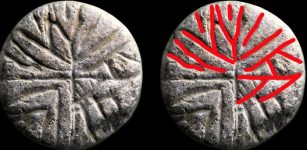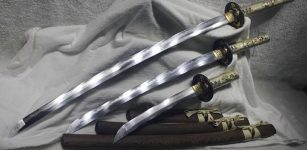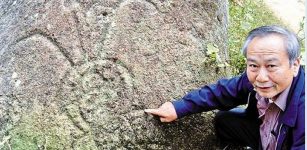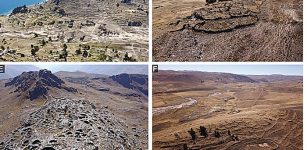‘Nuraghi’ – Thousands Of Beehive-Like Towers Are Sardinia’s Greatest Mystery
A. Sutherland - AncientPages.com - We still need to learn more about our past. Here's an example.
Many races have ruled on Sardinia, but the only permanent feature of the island's prehistoric legacy is its stones and impressive, age-old towers known as the nuraghi.
Nuraghi Culture, Sardinia, Italy. Credit: Mihai Sorin Sirbu - Public Domain
They began to appear between 1900 and 730 BC and are still the island's greatest mystery.
Their builders were the so-called 'Nuraghians,' the second group of immigrants (after the Neolithic inhabitants of Sardinia), who came from the East during the third millennium BC.
The Nuraghians possessed considerable knowledge of architecture. They were an advanced culture from the very start. They began to build circular towers with sloping walls of natural stone; these structures are undoubtedly their legacy for future generations.
Although typical of Sardinia and only for this island, what the nuraghi have remained unclear.
According to Giovanni Lilliu, a great scholar of Sardinian archaeology, 'there are about 7.000 well-preserved nuraghi. Considering the ravages of time and the numerous invasions, it is clear that the original number of nuraghi was considerably greater.'
Su Nuraxi is a Nuragic archaeological site in Barumini, Sardinia, Italy. The complex is centered around a three-story tower built around the 16th century BC. Credit: Credit: Norbert Nagel - CC BY-SA 3.0
We need to find out what language the Nuraghians spoke. These people left behind no recorded history. As far as we know, they, unfortunately, had no form of writing.
Modern-day Sardinians call the nuraghi "high pillars" or "hollow towers."
Every nuraghe is a unique archaeological site that may be similar to other nuraghi but never the same.
The conical towers with truncated flat tops shaped like beehives consist of rough, unhewn stones piled layer on layer to form a building with inward-sloping walls.
Many of the nuraghi are only a few feet high, but some are of considerable size, reaching more than sixty feet. They were built of natural stones and without cement. Only the weight and position of the stones keep the walls standing. The rocks are well tied in one to the other using a building technique based on experience, which ensures that the walls would not fall.
Some were cut to shape when the stones were laid to fit perfectly. Their walls - built in a concentric circular shape - are between six and sixteen feet thick. The low towers contain only one chamber, but the tallest ones have three stories, circular stairs leading to the upstairs rooms, and niches and spaces cut out.
Nuraghe La Prisciona, Nuraghe village near Arzachena, Sardinia. Heinz-Josef Lücking - CC BY-SA 3.0 de
What was the purpose of the nuraghi, and from what part of the world was their prototype imported? How were the stones - usually hard basalt - cut and dressed by builders with no metal tools harder than bronze or copper? How were they moved?
They were neither burial places nor sanctuaries. Were they storehouses or dwellings? Some had defensive qualities, which was necessary because the Ligurians repeatedly attacked Sardinia, Phoenicians, Carthaginians, and, eventually, Romans.
The nuraghi were probably used by people exposed to continual attacks who needed refuge in emergencies.
Researchers also explored the towers' possible astronomical alignments. Builders turned the door towards the southeast, where the sun was known to rise, and several of the nuraghi's small windows had solar, lunar, and stellar alignments.
Written by – A. Sutherland AncientPages.com Staff Writer
Updated on February 7, 2024
Copyright © AncientPages.com All rights reserved. This material may not be published, broadcast, rewritten or redistributed in whole or part without the express written permission of AncientPages.com
More From Ancient Pages
-
 Unexpected discovery of hidden color in ancient mummy portraits
News | Aug 27, 2015
Unexpected discovery of hidden color in ancient mummy portraits
News | Aug 27, 2015 -
 Playing Piece With Runic Inscription Found In Trondheim
Archaeology | Jun 20, 2023
Playing Piece With Runic Inscription Found In Trondheim
Archaeology | Jun 20, 2023 -
 The Navajo People In The Land Of The Four Sacred Mountains
Civilizations | Jun 10, 2020
The Navajo People In The Land Of The Four Sacred Mountains
Civilizations | Jun 10, 2020 -
 Fascinating Ancient History Of Roman Shields
Featured Stories | Oct 1, 2018
Fascinating Ancient History Of Roman Shields
Featured Stories | Oct 1, 2018 -
 Vikings’ Legacy Is Still Alive In Ireland – DNA, Ancient Ruins And Modern Cites Reveal
Civilizations | May 22, 2021
Vikings’ Legacy Is Still Alive In Ireland – DNA, Ancient Ruins And Modern Cites Reveal
Civilizations | May 22, 2021 -
 Native Americans Helped Shape The Klamath’s Forests For A Millennia Before European Colonization
Archaeology | Mar 21, 2022
Native Americans Helped Shape The Klamath’s Forests For A Millennia Before European Colonization
Archaeology | Mar 21, 2022 -
 3,000-Year-Old Graves With Some Oldest Burial Sites Discovered in Central Norway
Archaeology | Dec 8, 2017
3,000-Year-Old Graves With Some Oldest Burial Sites Discovered in Central Norway
Archaeology | Dec 8, 2017 -
 Samurai Swords: Katana And Wakizashi And Their Long Tradition
Ancient Traditions And Customs | Aug 6, 2018
Samurai Swords: Katana And Wakizashi And Their Long Tradition
Ancient Traditions And Customs | Aug 6, 2018 -
 Negev Desert’s Ancient Site Tells Story About Humans, Neanderthals Coexistence
Archaeology | Jun 19, 2021
Negev Desert’s Ancient Site Tells Story About Humans, Neanderthals Coexistence
Archaeology | Jun 19, 2021 -
 Ancient Roman Sarcophagus With A Female Skeleton And A Perfume Bottle Discovered In Turkey
Archaeology | Dec 27, 2019
Ancient Roman Sarcophagus With A Female Skeleton And A Perfume Bottle Discovered In Turkey
Archaeology | Dec 27, 2019 -
 19 Cannons Shot From British Ships During The American Revolution Discovered In Savannah River
Archaeology | Apr 29, 2022
19 Cannons Shot From British Ships During The American Revolution Discovered In Savannah River
Archaeology | Apr 29, 2022 -
 On This Day In History: The Peace Of Etaples Signed Between Kings Of France And England – On Nov 3, 1492
News | Nov 3, 2016
On This Day In History: The Peace Of Etaples Signed Between Kings Of France And England – On Nov 3, 1492
News | Nov 3, 2016 -
 Why Is The History Of Striped Clothing Dark And Sinister?
Featured Stories | Feb 12, 2025
Why Is The History Of Striped Clothing Dark And Sinister?
Featured Stories | Feb 12, 2025 -
 Ancient DNA Sheds Light On ‘Lost’ Indigenous People Of Uruguay And Reveals A Surprising Connection
Archaeology | May 11, 2022
Ancient DNA Sheds Light On ‘Lost’ Indigenous People Of Uruguay And Reveals A Surprising Connection
Archaeology | May 11, 2022 -
 Puzzling Biological Event 7,000 Years Ago – Something Weird Happened To Men
Archaeology | Jun 1, 2018
Puzzling Biological Event 7,000 Years Ago – Something Weird Happened To Men
Archaeology | Jun 1, 2018 -
 ‘Impossible’ Ancient Egyptian Visit Troubles Historians
Ancient Mysteries | Feb 11, 2021
‘Impossible’ Ancient Egyptian Visit Troubles Historians
Ancient Mysteries | Feb 11, 2021 -
 Chang’e: Chinese Goddess Of Moon And Immortality
Chinese Mythology | Aug 7, 2019
Chang’e: Chinese Goddess Of Moon And Immortality
Chinese Mythology | Aug 7, 2019 -
 Extraterrestrial Visit Recorded On Stone: They Came From The Stars
Featured Stories | May 4, 2014
Extraterrestrial Visit Recorded On Stone: They Came From The Stars
Featured Stories | May 4, 2014 -
 Pukaras: Fortified Impenetrable Hillforts In The Andean Highlands – A New Study
Places | Feb 7, 2024
Pukaras: Fortified Impenetrable Hillforts In The Andean Highlands – A New Study
Places | Feb 7, 2024 -
 On This Day In History: The Battle Of Fulford – King Hardrada Against Saxon Troops – Was Fought – On Sep 20, 1066
News | Sep 20, 2016
On This Day In History: The Battle Of Fulford – King Hardrada Against Saxon Troops – Was Fought – On Sep 20, 1066
News | Sep 20, 2016



